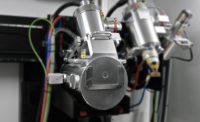NDT | Neutron CT
Neutron Computed Tomography Offers Unique Inspection Capabilities
Unlike standard x-ray computed tomography, neutron CT offers unique capabilities for inspections that cannot be effectively performed using traditional methods.

Image Source: Adisonpk / iStock / Getty Images Plus
Neutron computed tomography (nCT) is a nondestructive testing (NDT) method. The method involves penetrating an object with neutron radiation and capturing multiple cross-sectional images of the object from hundreds to thousands of angles as it is rotated a full 360 degrees. The images are then reconstructed using specialized software(s) to generate a three-dimensional representation of the internal structure of the object.
Many similarities exist between nCT and X-ray computed tomography (xCT). Both methods are used for imaging the internal structure of objects and both provide a 3D perspective of the entire part, however, they differ in the type of radiation used to penetrate the object. With nCT, instead of using X-rays, neutrons are employed as a type of penetrating radiation. Neutrons, like X-rays, pass through the object being examined and are absorbed to varying degrees based on the material properties of the object. The radiation that passes through the object is collected by a digital detector.
While nCT is beginning to gain commercial acceptance and increased usage, standard 2D neutron radiography (N-ray) has been around for nearly 100 years. It is used across many industries and is specified as required for many critical applications. Why use neutrons instead of X-rays? Both methods provide an image of the internals of a part, however, X-rays and neutrons interact quite differently within the atomic structure. This atomic interaction is straightforward, but a little refresher on an atom structure will help in understanding it.
An atom consists of a nucleus, composed of protons and neutrons, which are surrounded by a cloud of electrons. The electrons are distributed in energy levels or shells, and they orbit around the nucleus.

With this structure in mind, the main difference between neutrons and X-rays is that when X-rays are aimed at components, they interact with electrons. Neutrons on the other hand, interact with components’ nucleus. Figure 2 shows this quite well and this interaction makes for a dramatic difference in the absorption of energy. This is critical to the resulting images between standard X-ray radiography and neutron radiography, and of course the CT application of both methods as well.

These atomic level differences are the answer to the “why” question, but what does this mean for NDT? Again, for most applications the simple answer is absorption and/or penetration. Most materials will absorb X-rays and neutrons very differently. As an example, lead is used by nearly all X-ray system manufacturers as an X-ray absorber. They use lead to shield these systems for safety, because the correct amount of lead can effectively absorb all the X-rays the system can produce. Lead has a high atomic number and density, which means it has a large number of electrons and these items make it ideal for absorbing X-rays. On the other hand, when lead is imaged with neutrons, some smaller degree of the neutrons gets absorbed by the nucleus of the lead, but the vast majority pass through the material easily. As another example, many rubbers and plastics absorb few X-rays, but many of the elements in the materials absorb a good number of neutrons. As the examples suggest, different materials can be imaged with both X-rays and neutrons, and the results will be dramatically different.
This difference in absorption also allows for another unique aspect of nCT, which is something called “tagging.” Tagging is a process where objects can be inundated under a vacuum in a liquid solution that contains a neutron absorbing element called Gadolinium (Gd). Gd absorbs a vast number of neutrons. If during the tagging process, the Gd is absorbed by a secondary material, then that material will have a dramatic contrast difference on the neutron radiograph or nCT data file. Figure 3 is an image of two turbine blades. Figure 3A has no residual ceramic core and Figure 3B has residual core that has absorbed the Gd and is easily identifiable.

Although there is similarity to xCT, the usage of each method is dramatically different. Unlike xCT, which has been active for over 50 years and has now become a common tool for quality control and inspection processes, nCT is a relatively newer method having been in existence for only about 20 years. Its adoption has been slower compared to xCT, primarily due to several factors including limited commercial availability, technological challenges, and higher costs associated with neutron sources.
Despite these challenges, nCT has been gaining traction in multiple industries. This is especially true in the research sector where it has been applied for many scientific studies and experiments. In addition, in the last few years, there has been a growing interest in transitioning nCT from research settings to production environments. This is driven by its unique potential for providing valuable insights into the internal structure of materials and components.
NDT
Related Articles
As commercial availability increases and technology advances, several trades are starting to explore the potential applications of nCT, particularly for inspecting lower volume and critical products where the detailed imaging capabilities of neutron radiation offer unique advantages.
Because of the unique sensitivity differences between nCT and xCT, there are many specific NDT applications for nCT being explored. The collected data sets are being used for various inspection needs. Although most of the applications are confidential, some of the inspection focus has been in areas such as disparate materials, large and dense materials, organics, and other difficult to X-ray items. The inspections detect issues like flaws, wall thickness variations, influx completeness, and other critical needs. Many diverse manufacturers are discovering a need for this testing method that is sensitive to issues that are blind in traditional X-ray. This is especially true where internal geometry and product integrity is critical.
In summary, neutron computed tomography (nCT) is a nondestructive testing (NDT) method that has emerged over the past two decades. It is gaining traction across various industries and applications. Unlike standard X-ray computed tomography (xCT), nCT offers unique capabilities for inspections that cannot be effectively performed using traditional methods. As a result, it is becoming increasingly valuable in manufacturing, research, and quality inspections. It is filling a previously unmet need in multiple fields. With its potential to provide detailed insights into the internal structure of materials and objects, nCT is poised to become an indispensable tool in a wide range of industries.
Looking for a reprint of this article?
From high-res PDFs to custom plaques, order your copy today!





